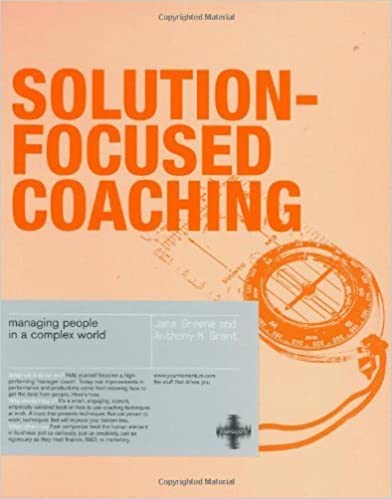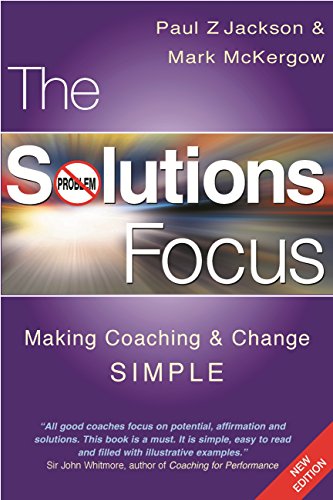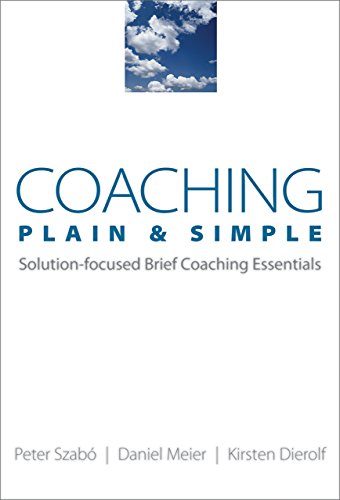Harness the power of Solution-Focused Coaching – Part 1
By Dr. Joe Isbister

Do more of what works! This is why Solution Focused approaches in both therapy and coaching have gone from strength to strength since its genesis in the 1970s. Here are some of the fundamentals of solution-focused approaches. Plus an introduction to some of the tools, techniques and books you can use to incorporate solution-focused approaches into your coaching.
Where does the Solution-Focused Coaching approach come from?
Solution-Focused Coaching (SFC) is an application of Solution-Focused Brief Therapy (SFBT) which began in the late 1970s with the work of American social workers Steve de Shazer, Insoo Kim Berg and their team at the Milwaukee Brief Family Therapy Center. SFBT emerged through analysing thousands of hours of recorded therapy sessions and painstakingly studying the moments that reliably led to positive therapeutic change on the part of their clients.
Steve de Shazer and Insoo Kim Berg noticed one overarching theme: Things work best when there is a shift away from the ‘problem’ and when there is more of an emphasis on future-focused answers and solutions. This contradicted the prevalent zeitgeist at the time which advocated the need to deeply understand the history, prevalence and complexity of a problem. In fact, SFBT would go on to say that talk of unpacking a problem can actually, in some instances, make the problem worse.
What is a Solution-Focused approach?
SFBT is as much a philosophy as it is a model. Steve de Shazer and Insoo Kim Berg advocate the following tenets to be central to SFBT:
- Focus on what works. Do more of it. Do less of what does not work.
- People are inherently resourceful and creative. When working collaboratively with people, they are readily able to define their own future-focused, goal-orientated solutions to problems. Therefore, a SFBT practitioner’s role is to facilitate the client to get towards this point.
- Even the most persistent problem is not present absolutely all of the time. There are always some exceptions. These exceptions can be used as a starting point to creating possible solutions.
- Change occurs with a series of small, manageable steps. Small changes can lead to big changes.
- There is always a better way. Focus on the future, not the past. The future is both fluid and negotiable.
As the evidence base for SFBT has grown, various pioneers including Steve de Shazer and Insoo Kim Berg themselves have been instrumental in spreading their ideas across different fields, including social work, counselling, education, sports and business.
What does Solution-Focused work look like?
Solution-focused work has come to be known by a number of distinctive techniques. These techniques can be honed and crafted to ‘shift’ clients’ attention away from going over ‘the problem’ and moving them towards thinking in a more tangible, collaborative, creative and solution-orientated way. Take a look at the ideas below. These will help to guide you through some of the more common techniques which have become associated with solution-focused work.
Goal setting and establishing a Client’s “Best Hope”
One of the first steps is for the practitioner to identify and clarify future-focused, definable goals with the client. This may be in relation to shorter-term focuses, like the hopes and expectations of a particular session, but also on longer-term goals and preferred futures in a client’s life.
What this might look like in action?
What is your ‘best hope’ from our time together?
What would you like to achieve in the next week / month / year? How would you know that you have achieved this?
The coping and compliment questions
Noticing and amplifying previously hidden or unrecognised strengths, coping mechanisms or resiliency factors already at play. Reflecting these words and observations back to a client in the form of a compliment or specific encouragement.
What this might look like in action?
It says a lot that despite these difficulties, you turned up today…
What have you found helpful in managing this situation?”
You say you can’t continue to work towards your goals. What has helped you to work on them up until now?
Exception finding
Noticing times when some aspect of the clients’ goal was already happening to some degree. Then reflecting and building on this, as a way of moving closer towards solutions.
What this might look like in action?
Talk to me about a time when this problem was not so bad for you or you handled it in a different way?
Can you tell me about a time when the problem was not present in your life?
Is there anything you can identify you are doing well in relation to this problem?
The Miracle Question
A powerful technique which gets a client to imagine life without the problem.
What this might look like in action?
Imagine you woke up tomorrow and this problem had disappeared. What would that look like? What would the first signs that the miracle had occurred? How would things be different?
Scaling questions
Making your client quantify the severity / prevalence of a problem. Usually on a 1-10 scale. This can then be used to bounce related questions off.
What this might look like in action?
On a scale of 0 to 10, how would you rate your progress in finding and implementing a solution to the problem?
What would it take to go up this scale, by just one point?
Has it always been at this point? When was it higher up on this scale?
Solution-Focused Coaching Books
If you would like to dive deeper into this approach and to harness its power in your practice then these three books will be well worth reading.
You may also like to read more about this topic in this next blog. The Solution in Solution-Focused Coaching: Why does it work?
Developing resourcefulness
Taking a solution-focused approach, making it a part of your coaching repertoire, can enhance your own and your clients’ capacity to positively shape their way forwards. If you want to know more about this approach and other ways to develop your clients’ resourcefulness, do get in touch.










